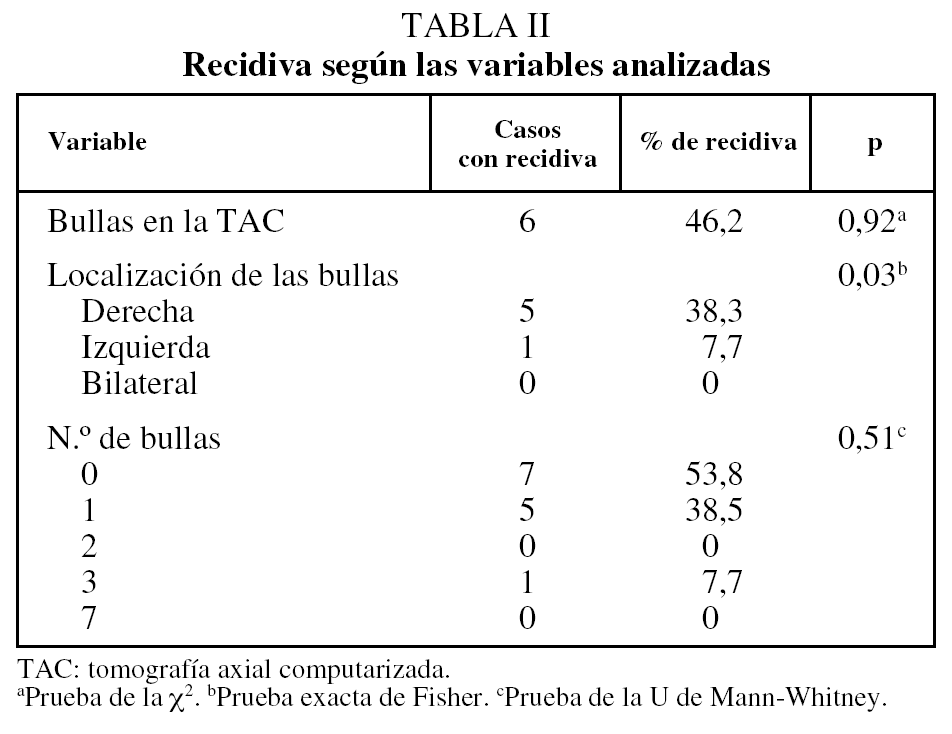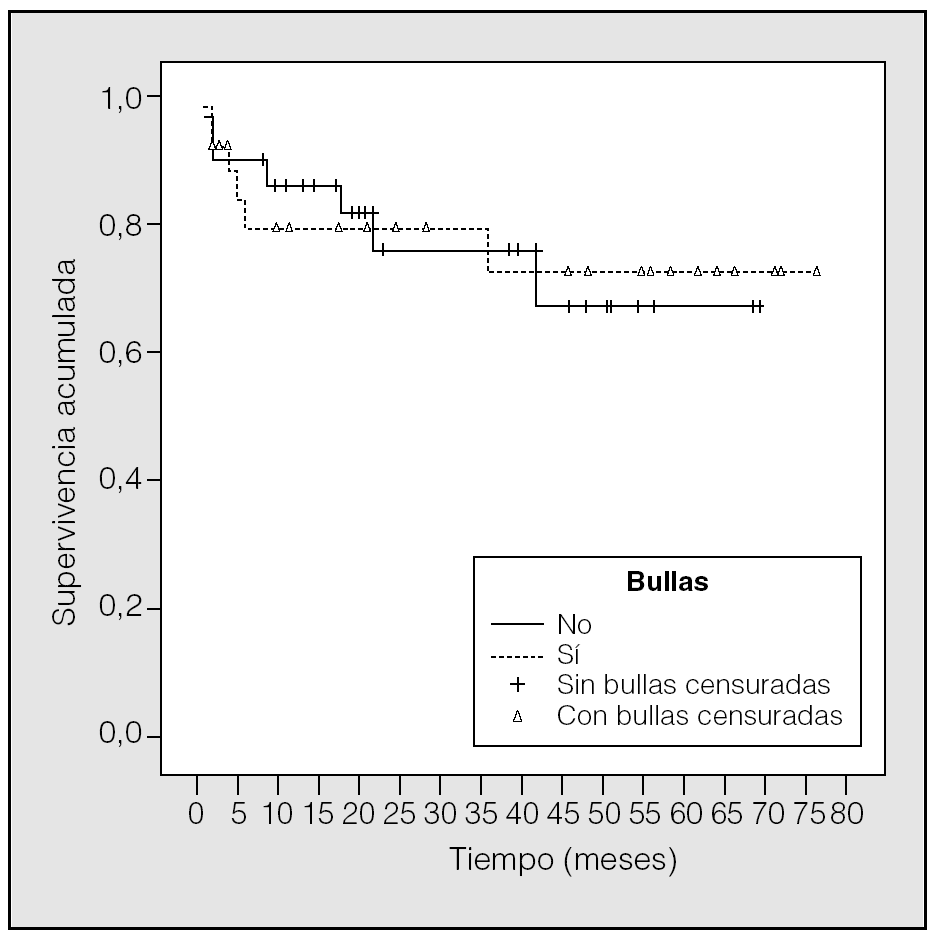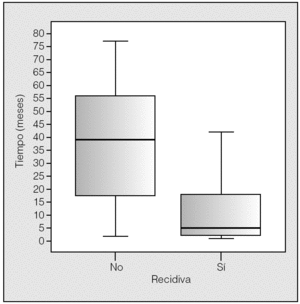Introducción
El neumotórax espontáneo es una enfermedad relativamente frecuente, cuya incidencia en España varía entre 7,4 y 28 casos por 100.000 habitantes/año para los varones y entre 1,2 y 10 casos por 100.000 habitantes/año para las mujeres1. Se admite que la causa más probable de neumotórax espontáneo en personas por otro lado sanas es la rotura de bullas o blebs subpleurales, que en un momento determinado comunicarían el árbol bronquial con la cavidad pleural y producirían el consecuente colapso pulmonar2. Por lo tanto, si la presencia de bullas es un factor de riesgo para un primer episodio de neumotórax espontáneo, parece lógico pensar que estas lesiones pudieran estar relacionadas también con el riesgo de recidiva tras este primer episodio.
Por otro lado, la tomografía axial computarizada (TAC) de tórax ha demostrado ser una prueba mucho más sensible que la radiografía simple de tórax para la detección de estas lesiones3. Así pues, el hallazgo de blebs o bullas en la TAC podría condicionar un mayor riesgo de recidiva tras un primer episodio de neumotórax espontáneo, por lo que nos planteamos en nuestro estudio la siguiente hipótesis de trabajo: la presencia de bullas en la TAC tras un primer episodio de neumotórax espontáneo primario supone un incremento del riesgo de recidiva de neumotórax y puede ser la base para indicar tratamiento quirúrgico electivo.
Pacientes y métodos
Se diseñó un estudio prospectivo en el que se incluyó a los pacientes con un primer episodio de neumotórax espontáneo primario o idiopático, confirmado mediante radiografía anteroposterior de tórax. Se excluyeron las recidivas de neumotórax cuyo primer episodio se hubiera producido antes de iniciar el estudio. Asimismo, se excluyó a los pacientes en los que, antes o después del neumotórax, se confirmó alguna enfermedad pulmonar concomitante.
Desde mayo de 1999 hasta diciembre de 2005 acudieron al Hospital General de Castellón 55 pacientes (41 varones y 14 mujeres) por presentar un primer episodio de neumotórax espontáneo primario. Todos ellos ingresaron en la Sección de Cirugía Torácica del Servicio de Cirugía General y del Aparato Digestivo de dicho hospital y fueron tratados según las recomendaciones de la Sociedad Española de Neumología y Cirugía Torácica (SEPAR)1. De este modo, en los casos con un neumotórax menor del 20% en la radiografía de tórax (calculado mediante la fórmula propuesta por Collins et al4) que se hallaban asintomáticos se instauró un tratamiento conservador mediante observación y control radiológico a las 24-48 h. Por el contrario, los pacientes sintomáticos (disnea, dolor intenso, descenso de la saturación de oxígeno), con un neumotórax mayor del 20% o los tratados inicialmente mediante observación en los que el neumotórax había aumentado fueron tratados mediante la inserción de un tubo de drenaje pleural de 20, 24 o 28 F. El lugar de inserción en todos los casos fue el quinto o sexto espacios intercostales, en la línea axilar anterior. Si a las 48 h no había fuga aérea, se pinzó el tubo de drenaje y se comprobó la reexpansión pulmonar mediante una nueva radiografía, antes de retirar el drenaje. Cuando la fuga aérea persistió más de 5 días, se consideró indicación de cirugía, y en este momento se excluyó a los pacientes del estudio.
Una vez comprobada la resolución del neumotórax, mediante reexpansión completa y persistente del pulmón en la radiografía de tórax, se solicitó una TAC torácica que se realizó entre las semanas 1 y 16 posteriores al neumotórax. El estudio radiológico se hizo mediante una TAC helicoidal, modelo Toshiba Asteion©, de 4 hélices, con cortes desde los vértices hasta las bases pulmonares, con un grosor de 3 mm y un pitch de 5,5, con características de parénquima y con filtro pulmonar. Se valoraron la presencia y el número de bullas, así como su tamaño y localización. La lectura de las imágenes fue efectuada siempre por la misma radióloga, quien desconocía los síntomas, la localización del neumotórax y el tratamiento efectuado en cada caso.
Con posterioridad se realizó un seguimiento anual de los pacientes. En el momento de cerrar el estudio se localizó telefónicamente a todos ellos para comprobar si habían presentado recidiva de la enfermedad desde su última visita. Se consideró que había habido recidiva cuando se demostró la presencia de neumotórax en las radiografías de tórax efectuadas por cualquier motivo.
Análisis estadístico
El análisis descriptivo se centró en la comparación de las diversas variables recogidas frente a la presencia o ausencia de recidiva. La inferencia estadística también giró alrededor de las mismas comparaciones. Para las variables cualitativas se utilizó en principio la prueba de la χ² pero, si alguno de los valores esperados en cualquier celda de las tablas de contingencia era menor que 5, se aplicó la prueba exacta de Fisher. Para las variables cuantitativas se utilizó la prueba no paramétrica de Mann-Whitney, puesto que no pudo asegurarse su distribución normal. Para el análisis simple de supervivencia de recidivas se utilizó el método de Kaplan-Meier con la prueba de Breslow para la inferencia entre presencia y ausencia de bullas. No se recurrió a la prueba de los rangos logarítmicos al no poderse asegurar la proporcionalidad de riesgos. Los diversos análisis se realizaron con el programa SPSS® versión 12.0.1. Para la significación estadística se adoptó el clásico nivel del 5% en el valor p.
Las variables analizadas fueron: presencia de bullas en la TAC, localización, número y tamaño.
Resultados
Tiempo de seguimiento
El tiempo de seguimiento medio fue de 30,7 meses, con un intervalo de confianza (IC) del 95% de 24-37. La mediana de seguimiento fue de 22 meses (rango: 1-76). El percentil 25 fue de 9,7 y el percentil 75 obtuvo un valor de 51, con una amplitud intercuartílica de 41. Por lo tanto, se deduce que estos 41 meses abarcan el seguimiento de los casos más representativos de la muestra (tabla I).
Cuando se comparó el tiempo de seguimiento de los pacientes que presentaron recidiva con el de aquellos que no la presentaron, se observaron ciertas diferencias (fig. 1). Así, en el grupo sin recidiva la mediana de seguimiento fue de 39 meses, con un mínimo de 2 y un máximo de 76. El percentil 25 alcanzó un valor de 16,63 meses, y el percentil 75, de 55,9 meses, con una amplitud intercuartílica de 39 meses. De esta forma, en el grupo sin recidiva los pacientes más característicos se siguieron entre 16,6 y 55,9 meses. Por otro lado, en el grupo que presentó recidiva, al concluir el seguimiento en el momento en que se produjo la recurrencia, la mediana de seguimiento fue de 5 meses, con un mínimo de 1 mes (recidiva más precoz) y un máximo de 42 meses (recidiva más tardía). Los percentiles 25 y 75 tuvieron unos valores de 1,5 y 20 meses, respectivamente, con una amplitud intercuartílica de 19. Por lo tanto, en este grupo, al ser el tiempo de seguimiento equiparable al tiempo de recidiva, puede concluirse que lo más representativo de la recidiva es que ocurra entre 1,5 y 20 meses tras el neumotórax inicial. Como la mediana (línea gruesa horizontal en el interior de las cajas) es inferior a la media aritmética en este grupo de pacientes con recidiva, se comprende que la recidiva se produjo, especialmente, durante el primer año.
Fig. 1. Diagrama de cajas del tiempo de seguimiento según la aparición de recidiva.
Bullas en la tomografía computarizada y recidiva
De los 55 pacientes, se observaron bullas en 26 (47,3%) y no las presentaban 29 (52,7%). En el grupo que presentaba bullas, hubo 6 casos (46,2%) de recidiva. En el grupo sin bullas el número de recidivas fue de 7 (53,8%). No encontramos diferencias significativas entre la presencia de bullas en la TAC y el índice de recidivas (χ² = 0,009; grados de libertad = 1; p = 0,92) (tabla II).
Localización de las bullas y recidiva
En cuanto a las bullas encontradas en la TAC de los 26 pacientes mencionados, 12 eran derechas, 2 izquierdas y 12 bilaterales. Ningún paciente con bullas bilaterales presentó recidiva. De los que presentaban bullas derechas recidivaron 5, y de los que las presentaban en el pulmón izquierdo recidivó uno. Con la prueba exacta de Fisher se obtuvo la significación estadística suficiente (p = 0,03) para afirmar que existe una asociación entre la localización de las bullas y la aparición posterior de recidiva, de forma que recidivan más los pacientes con neumotórax que presentan bullas en el lado derecho que los que las tienen en el izquierdo (tabla II).
Número de bullas y recidiva
De los 55 pacientes incluidos en el estudio, 29 (52,7%) no presentaban ninguna bulla en la TAC. El número de recidivas en este grupo fue de 7. Se encontró una bulla en 11 pacientes (20%); en este grupo se produjeron 5 recidivas. En 12 ocasiones se encontraron 2 bullas, pero ninguno de estos pacientes presentó recidiva. En 2 pacientes se encontraron 3 bullas, y uno de ellos presentó una recidiva. En un caso se demostraron 7 bullas, sin que hubiera recidiva. Puede concluirse que hay una tendencia mayor a la recidiva en los pacientes con una única bulla en la TAC que en aquéllos con más bullas, pero no se puede descartar que sea debido al azar (Mann-Whitney, p = 0,51) (tabla II).
Tamaño de las bullas y recidiva
El tamaño medio de la bulla mayor en la TAC fue de 0,5 cm, con un mínimo de 0 cm y un máximo de 2 cm. En el grupo de pacientes con recidiva la media ± desviación estándar fue de 0,6 ± 0,7 cm, y en el de los que no presentaron recidiva, de 0,51 ± 0,8 cm. No hay, pues, diferencias con respecto a la recidiva según el tamaño de las bullas.
Supervivencia sin recidiva según la presencia o ausencia de bullas
Tras realizar un estudio de supervivencia mediante el método de Kaplan-Meier (fig. 2), observamos los resultados que se exponen a continuación. Hay que tener en cuenta que se consideran pacientes "censurados" aquellos que no presentaron recidiva y, por lo tanto, completaron el seguimiento hasta que se cerró el estudio.
Fig. 2. Curva de supervivencia de Kaplan-Meier.
1. Entre los pacientes sin bullas, la media de supervivencia sin recidivas fue de 53 meses, con un error estándar de 5 y un IC del 95% entre 42 y 63 meses. Como se ve en la figura 2, la probabilidad acumulada de supervivencia fue descendiendo desde 0,93 en el mes 1 hasta 0,7 en el mes 42.
2. En los pacientes que presentaron bullas, la media de supervivencia sin recidivas fue de 59 meses, con un error estándar de 6 y un IC del 95% entre 46 y 71. La supervivencia acumulada descendió desde su valor inicial 0,9 en el mes 1 hasta 0,7 en el mes 36.
Aunque globalmente no se encontraron diferencias significativas en la supervivencia sin recidiva entre los pacientes con bullas y sin ellas (p = 0,88, con el test de Breslow), conviene hacer algunas consideraciones de interés sobre los resultados obtenidos. En la curva de supervivencia de Kaplan-Meier puede observarse que los pacientes que presentaron bullas recidivaron, principalmente, durante los 6 primeros meses tras el episodio de neumotórax, con una caída brusca de la supervivencia en este tiempo, para luego mantenerse casi constante. Por el contrario, cuando no se presentaron bullas, la supervivencia disminuyó, pero de forma más progresiva, sin una clara influencia del tiempo, con recidivas intermitentes y, aparentemente, aleatorias.
Discusión
Tras un primer episodio de neumotórax espontáneo primario, la recidiva es la complicación más frecuente y la posibilidad de recurrencias aumenta del 20 al 60 y al 80%, según se trate del primer, segundo o tercer episodios, respectivamente2.
Lippert et al5, en 1991, encontraron 4 factores con significación estadística que incrementaban el riesgo de recidiva tras un primer episodio de neumotórax espontáneo: edad mayor de 60 años, presencia de fibrosis pulmonar, ser no fumador y tener una constitución corporal alta y delgada. Sin embargo, dichos autores no estudiaron la presencia de bullas. Senac et al6, aunque sin dar cifras exactas en su estudio preliminar, habían hablado ya de 4 criterios en la TAC que condicionarían mayor riesgo de recurrencia, a saber: bullas con tensión, tamaño mayor de 3 cm, mayor número de lesiones (sin especificar cuántas) y localización de las bullas en el ápex. Por su parte, Warner et al7 fueron los primeros en evaluar numéricamente la importancia de las bullas en la recidiva de los neumotórax. En un interesante trabajo afirmaron que puede predecirse la historia natural de los neumotórax mediante los hallazgos en la TAC torácica, aunque admitían que el número de casos (n = 26) era demasiado bajo para determinar el número de bullas que podían tener repercusión en la recidiva. Posteriormente, Sihoe et al8 publicaron un estudio de 28 pacientes y concluyeron que, en efecto, la presencia de bullas en la TAC era un factor de riesgo de recidiva contralateral tras un primer episodio de neumotórax espontáneo y, por lo tanto, la TAC puede utilizarse para indicar la cirugía bilateral en pacientes con estas lesiones. A pesar de estos esperanzadores resultados, el estudio de Sihoe et al8 fue criticado posteriormente por presentar importantes errores metodológicos9,10. Torres-Lanzas y Rivas de Andrés11 afirmaron, sin embargo, que la presencia de bullas en la toracoscopia durante un primer episodio de neumotórax era un factor predictivo de recidiva y recomendaron la cirugía en estos casos.
En nuestro trabajo, coincidiendo con los resultados de otros autores3,12,13, no se ha conseguido demostrar que la presencia de bullas en la TAC sea un factor predictor de recidiva tras un primer episodio de neumotórax espontáneo. Tampoco ha podido demostrarse que su tamaño o número tengan una relevancia pronóstica. El único factor que alcanzó la significación estadística fue el lado donde se localizaban las bullas, de forma que, si un paciente presenta bullas en la TAC torácica, las probabilidades de recidiva son mayores si éstas se hallan en el lado derecho que en el izquierdo o son bilaterales.
En cuanto al momento en que ocurren las recidivas, la mayoría se produjo, de forma característica, durante el primer año posterior al neumotórax, por lo que este período podría considerarse el de mayor riesgo de recurrencia. Estos datos coinciden con los obtenidos por otros autores2,14. Al comparar la supervivencia (tiempo sin recidiva) de los pacientes con bullas y sin ellas, se comprobó que cuando éstas están presentes la recurrencia sucede, sobre todo, durante los 6 primeros meses, mientras que cuando no las hay el momento de la recidiva es impredecible, con episodios de recurrencia esporádicos, sobre todo, durante los 2 primeros años.
El tratamiento y el seguimiento de los neumotórax espontáneos no están todavía estandarizados y las recomendaciones terapéuticas suelen basarse en opiniones de expertos, muy diferentes según las diversas asociaciones científicas1,15-17. Sin embargo, desde principios de los años noventa la cirugía videotoracoscópica se ha impuesto y generalizado en el tratamiento de muchas enfermedades torácicas18, y en el momento actual se considera el procedimiento de elección para el tratamiento de los neumotórax que requieran cirugía, ya que disminuye el dolor postoperatorio, permite una rápida recuperación funcional y los resultados estéticos son más favorables; todo ello con una seguridad y unos índices de recidiva equiparables a los de la cirugía abierta1,19,20. Con esta clara disminución de la morbimortalidad, algunos autores han propuesto la cirugía de resección tras un primer episodio de neumotórax espontáneo si en la TAC se consigue demostrar la presencia de bullas6,21,22. En opinión de los autores, no se dispone de evidencia científica suficiente para someter a un paciente a cirugía tras un primer episodio de neumotórax espontáneo primario, aunque se observen bullas en la TAC. Es más, dado que la cirugía nunca puede considerarse exenta de riesgos, si se admite que el índice de recidivas tras un primer episodio de neumotórax se sitúa entre el 20 y el 45%2,21, el número de pacientes que nunca recidivarían y son sometidos a cirugía de resección es, a nuestro parecer, demasiado elevado para recomendarla de forma profiláctica.
En nuestra opinión, la utilidad de la TAC en los neumotórax espontáneos no radica en su capacidad de predecir nuevas recidivas lo que permitiría intervenciones quirúrgicas precoces, sino que su mayor ventaja es poder detectar lesiones y enfermedades potencialmente causantes de neumotórax (neumotórax secundarios) y, por supuesto, la planificación de la cirugía cuando ésta se ha indicado por diferentes motivos.
Por lo tanto, de acuerdo con nuestros resultados, no puede demostrarse que las bullas favorezcan la recidiva tras un primer episodio de neumotórax espontáneo primario. Aunque su presencia tiene poco peso en la recidiva, existe una tendencia a la recidiva más precoz en los pacientes que las presentan, si bien no puede descartarse el efecto del azar en esta observación. Por todo ello, y de acuerdo con nuestros datos, no puede sentarse una indicación quirúrgica bien fundada con el fin de prevenir las recidivas en los pacientes que presentan bullas detectables en la TAC tras el primer episodio de neumotórax espontáneo, especialmente si ya ha pasado un año o más desde tal episodio.
Correspondencia: Dr. D. Martínez-Ramos.
Servicio de Cirugía General y del Aparato Digestivo.
Hospital General de Castellón.
Avda. Benicàssim, s/n. 12004 Castellón. España.
Correo electrónico: davidmartinez@comcas.es
Recibido: 23-2-2006; aceptado para su publicación: 27-6-2006.

















